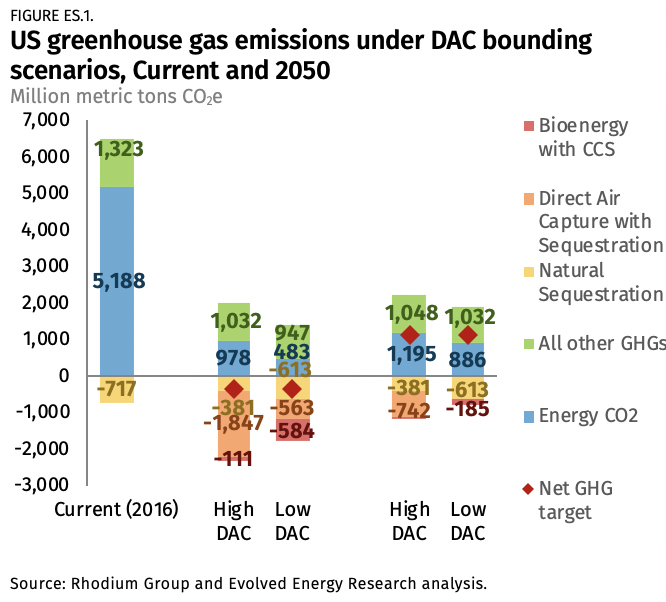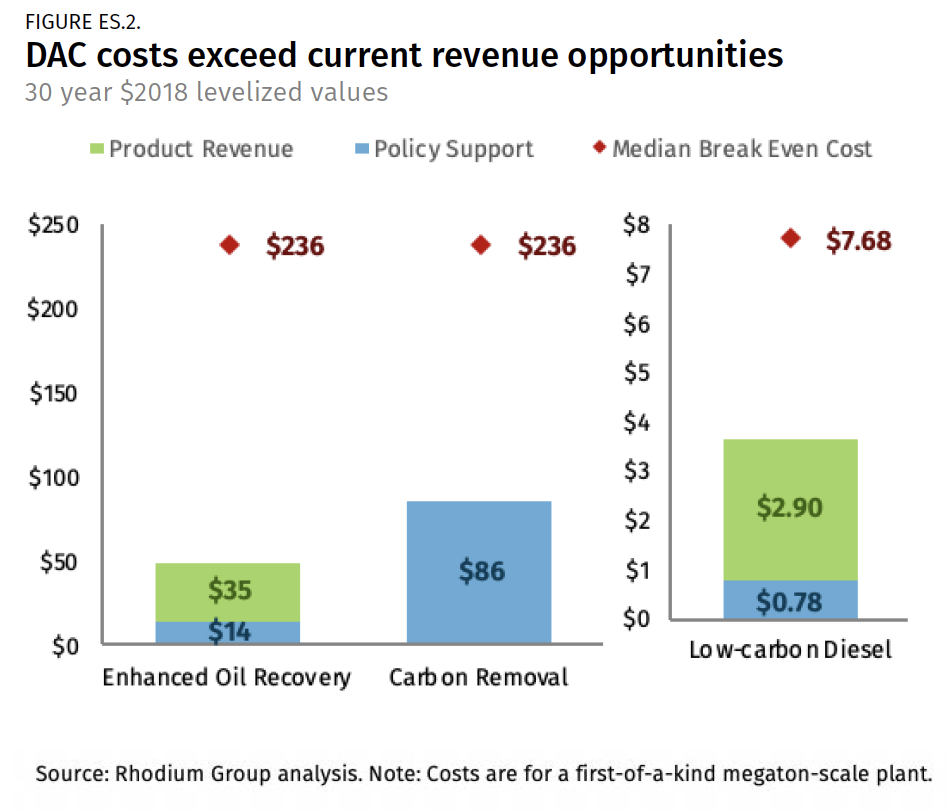Capturing Leadership: Policies for the US to Advance Direct Air Capture Technology
Significant policy action is required to ensure these technologies are available in time and at the scale required to avoid the worst impacts of climate change.
Growing evidence suggests that limiting global temperature increases to reasonably safe levels will require not only a rapid reduction in carbon dioxide (CO2) and other greenhouse gas emissions (GHGs) around the world but large-scale removal of CO2 from the atmosphere as well. Every year that global emissions continue unabated, the required pace of future reductions accelerates, and the quantity of CO2 emissions that ultimately needs to be removed from the atmosphere grows. Fortunately, thanks to recent technological innovations, the options for CO2 removal are increasing in number and falling in cost. But significant policy action is required to ensure these technologies are available in time and at the scale required to avoid the worst impacts of climate change.
This report focuses on one of these emerging carbon removal technologies: Direct Air Capture (DAC). DAC safely removes CO2 from the air using chemical filters and produces a concentrated stream of CO2 for use in products like concrete and fuels or for permanent geologic storage. Carbon180, the Linden Trust for Conservation, and the ClimateWorks Foundation asked Rhodium Group to conduct an independent analysis of the role DAC can play in supporting a decarbonized US future, its cost, and the actions required to achieve deployment at a scale that can have a global impact on reducing GHGs in the near, medium and long term.
We studied the latest peer-reviewed literature and conducted dozens of expert interviews to understand the state of the technology today concerning performance and costs. We modeled DAC’s role in a decarbonized US future, using trailblazing analysis to measure long-term need. We then developed a detailed set of policy options that can both accelerate the deployment of DAC and support the technology at the scale required for the US to deliver its contribution toward avoiding the worst impacts of climate change. Our key findings follow.
Getting to Zero Emissions by Midcentury Requires Large-Scale Carbon Removal with Direct Air Capture Technology
Last year, global CO2 emissions reached an all-time high. Recent scientific research indicates that global emissions need to reach net-zero between 2045 and 2055 to limit global temperature rise to 1.5 degrees Celsius. DAC technology does not make it possible to bypass the difficult work of reducing emissions. We find that even with break-neck electrification of vehicles, buildings, and industry, unprecedented improvements in energy efficiency, completely decarbonized power generation, and carbon removal from enhanced natural sequestration, DAC technology will be essential for the US to decarbonize by midcentury. Our analysis indicates that for the US to reach net-zero emissions by 2045 (our “100by45” scenarios) between 560 and 1,850 million metric tons of CO2 will need to be removed by DAC technology and then permanently stored underground annually, depending on the availability of other carbon removal options, such as bioenergy with carbon capture and storage (BECCS) and natural sequestration, and the pace of electrification in the transportation, buildings, and industrial sectors (Figure ES.1.).

Even under a less ambitious US target of 83% below 2005 levels in 2050 (our “83by50” scenarios), carbon removal technology remains necessary to offset stubborn sources of CO2 such as long-haul aviation and shipping, and energy-intensive industrial activities. There is growing scientific evidence that US forests and soils may absorb a smaller share of this carbon without widespread adoption of new agricultural and forestry practices. The same holds true for methane and nitrogen oxide emissions from farming and livestock, which if not tackled will also hinder progress toward eliminating GHG emissions. Achieving 83by50 requires unprecedented speed in transforming the energy sector, consumer patterns, and land use across the US. If carbon removal from other options falls short, up to 740 million tons per year of DAC with sequestration may be required by 2050.
DAC Deployment Is Achievable, and Technology Is Set to Break Through
Investing now in research and development would set the US on track to innovate and improve DAC technology today, so it’s ready for deployment when we need it most. Dedicated academic researchers and three commercial DAC companies have worked diligently over the last decade to improve the performance of the technology. Collectively, these companies have built 11 DAC plants around the world, the largest of which is located in Alabama and is designed to capture 4,000 tons per year. However, while some niche opportunities may exist now where DAC is economic, current market opportunities and policy incentives do not provide enough support for the first large-scale DAC plant to break even. This is the case across multiple DAC technology applications, even after accounting for existing policy incentives like California’s Low Carbon Fuel Standard (LCFS) and the Federal Section 45Q tax credit (Figure ES.2.). Drawing the historical deployment pathways of key electric power sector technologies, such as natural gas combined cycle power plants, wind, and solar, we find evidence to demonstrate the potential for policy to propel DAC to market. The US has done it before. It can be done again.

Federal Action Is Needed to Push and Pull DAC Into the Marketplace
To become a leader in DAC technology, the US must prioritize the construction of DAC plants to increase scale and reduce costs through learning and experience. We estimate that at least nine million tons of DAC capacity need to be operational in 2030 to get the US on track for meeting mid-century carbon removal requirements. The specific application of DAC–for use in fuels, products, enhanced oil recovery, or sequestration–matters little at this early stage as long as it advances progress toward the 2030 deployment goal. To ensure this happens, the federal government can pursue policy action on multiple fronts.
Enact and Fully Fund a Comprehensive Research, Development, and Demonstration (RD&D) Program for DAC
Among its developed-country peers, the federal government ranks in the middle of the pack in energy RD&D relative to the size of its economy. Over the last decade, the Department of Energy (DOE) spent $4 billion annually, on average. Meanwhile, the cumulative amount of government funding for DAC RD&D to date is $11 million. The landmark study of negative emissions technologies by the National Academies of Sciences, Engineering, and Medicine (NASEM) recommends funding DAC research over the next ten years at an average annual level of $240 million. Compared to DOE spending on every other applied energy RD&D program, this sum would be small (ES.3). Congress should authorize comprehensive DAC and sequestration research programs that reflect the recommendations from the NASEM, enact them into law, and fully fund them through appropriations.

Pursue Policy Pathways to Increase Demand for DAC
While RD&D is essential, a comprehensive industrial strategy should also stimulate demand for DAC technology. We assess three pathways for the federal government to do this based on existing policy frameworks and then quantify the level of support required to get at least nine million tons of DAC capacity built in the US through 2030. Fully implementing any one of these pathways should get DAC on track towards likely long-term deployment needs. These pathways include:
- Leverage Federal Procurement. The Department of Defense can ramp up competitive procurement of DAC based fuels from zero to roughly 23% of 2017 operational fuel consumption in 2030. The General Services Administration can launch a competitive procurement program for carbon removal from DAC with sequestration in addition to procuring low-carbon products made with DAC CO2.
- Improve the Section 45Q Tax Credit for DAC. Congress can make several improvements to this program all focused on DAC: extending the commence-construction deadline for DAC eligibility to the end of 2030; extending the credit payout period to 30 years; increasing the value of the credit for geologic storage to $180 per ton; and lowering the minimum capture and use thresholds to 10,000 tons per year. These changes will allow the first wave of commercial DAC plants to break even if they also incorporate revenue from California’s LCFS. The total annual cost to the government in 2031 would be just $1.5 billion to support nine million tons of DAC capacity, roughly half the current annual cost of solar photovoltaic (PV) tax credits.
- Establish a Federal Mandate for DAC Based Fuels. Congress can expand eligibility for the Renewable Fuels Standard or establish a standalone mandate for very low-carbon, drop-in fuels to increase consumption of DAC-derived fuels. By 2030, DAC-derived fuels need to equal roughly 0.4% of 2017 US on-road fuel consumption to achieve the goal of nine million tons of DAC capacity. Credit prices would need to be $2.50 per gallon to support the first DAC plant and $1.05 per gallon to support the ninth DAC plant.
Overcome Non-Cost Barriers to DAC Deployment
The federal government should act to address long-term geologic storage monitoring and liability. Doing so will provide certainty to project developers pursuing DAC with sequestration. Streamlined pipeline and CO2 storage permitting, can reduce costs and investment risks. The government should also facilitate sequestration projects by mapping geologic formations and assessing their suitability. Independent standard-setting organizations should proactively establish standards for CO2-based products such as concrete and aggregate, removing a key market barrier.
Lower the Cost of Investment
We assessed several existing federal policies that reduce the amount of investment required to finance DAC plants including Loan Guarantees, Master Limited Partnerships, Private Activity Bonds, and Investment Tax Credits. None of these policies alone would be sufficient to support the construction of nine million tons of DAC capacity through 2030, but they could complement deployment policies. We find that of the options considered, Congress should pursue an Investment Tax Credit of 30% for the most effective strategy. This approach is also well-proven, having been used to drive the rapid rise of solar PV deployment.
Leverage Opportunities for DAC in Infrastructure, Climate, or Energy Policy Frameworks
Many policy frameworks focused on other goals could be designed to provide support to DAC. This report guides how an infrastructure bill could be used to increase demand for DAC-based products like concrete. Clean Energy Standards on electric utilities can incorporate offset mechanisms to support DAC, similar to provisions currently in place in California’s Low Carbon Fuel Standard. Finally, if support arises for the federal government’s direct involvement in carbon removal, an existing or new agency could be tasked with constructing and operating DAC plants with geologic sequestration.
Shaping the Policy Environment to Support DAC With Sequestration at Scale
While discrete deployment policies outlined above can help get DAC off the ground and heading in the right direction through 2030, a broad policy framework capable of supporting hundreds or thousands of DAC with sequestration plants will be necessary. We identify two capable options for the federal government to pursue: carbon pricing and a public carbon removal agency.
Integrate DAC With Sequestration in Carbon Pricing
While politically challenging at the moment, a cap-and-trade program or carbon tax similar in ambition to the scenarios considered in this analysis should be sufficient to support long-term deployment of DAC with sequestration. Carbon pricing deploys DAC as part of an integrated, economy-wide decarbonization policy framework, an upside to this approach. To fully support DAC with sequestration, carbon pricing policies should include a mechanism to credit carbon that is removed from the air and permanently stored underground.
Establish a Federal Carbon Removal Administration
As an alternative to carbon pricing, the US could choose direct public funding for carbon removal. Mechanisms for supporting DAC with sequestration include mandating public procurement, codifying a permanent version of the Section 45Q tax credit, or authorizing a new public agency with sole responsibility for achieving negative-emissions goals. Similar to DOE’s Office of Environmental Management—which oversees the largest environmental cleanup operation in the world—Congress could charter a new agency that would receive dedicated funding to remove a specified amount of CO2 each year. Pursuing this option means separate policies to accelerate energy efficiency, end-use electrification, decarbonization of the electric power sector, and other mitigation and carbon removal actions would be necessary to meet the ambitious GHG reduction targets examined in this report.
Create a Roadmap for Deep Decarbonization
Meeting long-term US GHG reduction targets requires a fundamental transformation of the energy system. To enable this decarbonized future, the US should improve the siting of renewable energy plants and long-distance transmission lines. Electricity generation expands by up to triple current levels and becomes dominated by zero-carbon sources like wind, solar, nuclear, and natural gas with carbon capture and storage. Meanwhile, demand for coal and gasoline would be pushed to near zero by midcentury and demand for diesel and natural gas would decline dramatically. Our results highlight the need for further research on how incumbent industries should transition in a deeply decarbonized future.
The Opportunity for Global Leadership
The US has a long track record of leading the world in technological innovation. DAC is part of a suite of carbon capture utilization and storage breakthrough technologies recently identified by former Secretary of Energy Ernest Moniz and energy scholar Daniel Yergin as worth prioritizing for investment and policy support. With assets such as vast CO2 pipeline infrastructure, proven enhanced oil recovery capacity and more than 2 trillion tons of geologic storage capacity, the US is well-positioned to foster the development of DAC with sequestration. Fortunately, thanks to recent breakthroughs, the pathways to doing so are increasing in number and falling in cost. But just as is the case for other critical low-carbon technologies, like nuclear and carbon capture and sequestration, significant federal policy action is required to ensure DAC technology is available in time and at the scale to contribute to avoiding the worst impacts of climate change.